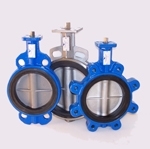What is the Difference Between Resilient Seated, High Performance, and Triple Offset Butterfly Valves?
For many processes that involve fluid material moving through pipe systems, butterfly valves are needed to stop or regulate flow. With this mechanism, a circular disc is designed to move perpendicular to the passage from fully closed to fully open or anywhere in between. It’s somewhat like a dimming switch. From full light the user can turn the lights down or completely off at the desired speed and vice versa.

Because of the many applications, designs are varied for the different types of butterfly valves. Pressure, heat, the potential for fire damage, precise operation, and longevity all factor into how a butterfly valve is manufactured to fit within a system.
The key differences between these are the location of the actuating system (the offset) and the material used to make the butterfly valve. Materials such as light alloy, aluminum, or PVC plastic are used for short-term or lower demand applications. Such materials aren’t enough to stand up to heavy-duty operations and require stronger construction.
Learning about the particular design and function of these butterfly valve type allows you to understand how they are similar yet distinctive.



